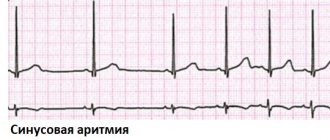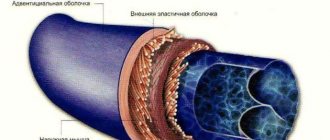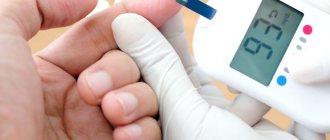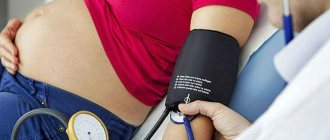1.General information
Shortness of breath (dyspnea) is a deviation of the frequency, depth and/or rhythm of breathing from similar indicators of a healthy person of the same sex and age under the same conditions. Despite some cumbersomeness of this definition, it seems quite complete and accurate. The term “shortness of breath” seems intuitive, which often leads to misunderstandings between the doctor and the patient, who put different meanings into this word.
There are several classifications of shortness of breath:
- inspiratory (on inspiration), expiratory (on exhalation) and mixed (difficulties in both phases of the respiratory act);
- tachypnea (rapid shallow breathing) and bradypnea (slow breathing);
- physiological shortness of breath (transient, reversible intensification of breathing as an adequate adaptive response of the body to stress, injury or objectively low oxygen content in the inhaled air, which requires additional oxygenation) and pathological shortness of breath (caused by airway obstructions, bad habits, cardiovascular failure, obesity, diseases lungs, hematopoietic system, etc.).
This material is devoted to a type of dyspnea called dyspnea at rest (sometimes also called dyspnea at rest). In contrast to the antonymous “shortness of breath on exertion,” which is sometimes difficult to distinguish from the normal physiological response of the respiratory system, resting dyspnea is a much more unfavorable clinical and prognostic sign.
Sign up for a consultation
A must read! Help with hospitalization and treatment!
When is it urgent to see a doctor?
Many people are interested in the question: if shortness of breath is tormented, when should you see a doctor so as not to miss the deterioration of your condition? “To help people know when they should see a doctor, it is worth using the pulse oximetry method more widely. There is a device that fits on your finger like a clothespin. It is absolutely accessible to most people, costs about one and a half thousand rubles. In principle, it is possible to buy it. Then, when there is shortness of breath, it is still necessary to control the saturation of tissues with oxygen. With this method it is quite possible to control it and focus on indicators. If normally saturated tissue saturation is 94-99%, then when this figure is less than 90%, this already requires respiratory support measures,” notes the pulmonologist. This means that in such a situation you need to see a doctor as soon as possible.
So if shortness of breath appears, you should not try to cope with it by breathing through the window, it is better to visit a doctor and undergo the necessary examinations. After all, the situation can worsen, sometimes it happens suddenly. Also, a constant lack of oxygen in full leads to the body suffering from hypoxia. And this is fraught with serious consequences - both external and internal.
There are contraindications, you should consult your doctor
2. Reasons
The most common causes of shortness of breath at rest (which also includes dyspnea under minor physical exertion, which does not cause changes in breathing in healthy individuals) are:
- cardiovascular failure, when normal blood circulation is disrupted, stagnation and swelling occurs in the lungs, gas exchange slows down and, as a result, hypoxemia develops (deficiency of bound oxygen in the blood);
- disturbances in the regulation of breathing on the part of the central nervous system (brain respiratory center) in certain neuropsychiatric disorders;
- pulmonary pathology (a wide range of diseases affecting the pulmonary parenchyma and/or airways);
- renal or liver failure, causing disturbances in general metabolism;
- diabetes mellitus and other endocrine disorders;
- diseases of the hematopoietic system (primarily anemia as a lack of red blood cells and hemoglobin, of which they are carriers);
- pathology of the spinal column and musculoskeletal structures of the chest.
Visit our Pulmonology page
Is shortness of breath at rest the most dangerous?
— When assessing the degree of respiratory failure, pulmonologists really pay attention to shortness of breath at rest. It ranks last in many scales of dyspnea severity. the mMRC dyspnea severity scale is popular in world practice .
this is what it looks like:
| Degree | Heaviness | Description |
| 0 | No | Shortness of breath occurs only during heavy physical activity. |
| 1 | Lightweight | Shortness of breath occurs when walking quickly on level ground or when climbing a small hill. |
| 3 | Average | Due to shortness of breath, patients walk slower than their peers, or when walking at their own pace on level ground, they must stop to catch their breath. |
| 4 | Heavy | After walking about 100 m or several minutes on level ground, the patient must stop to catch his breath. |
| 5 | Very heavy | Shortness of breath does not allow the patient to leave the house and appears when dressing or undressing. |
This scale is associated with a decrease in exercise intolerance and it shows that shortness of breath, which deprives a person of the ability to perform usual activities, is indeed the most severe.
3. Symptoms and diagnosis
Shortness of breath at rest - i.e. in a relaxed state, outside of physical activity, during sleep or rest - can manifest itself in different ways and be accompanied by various additional symptoms, which is determined by the root cause of respiratory disorders.
Thus, cardiovascular dyspnea is accompanied by tachycardia, cyanosis, coldness and swelling of the extremities; patients complain of the inability to “take a deep breath” and frequent attacks of “night suffocation.” Against the background of such attacks, whether at night or during the day, life-threatening conditions often develop.
Pulmonary dyspnea is characterized by chest pain, weakness, drowsiness, low-grade fever, cough, and asthmatic-type breathing difficulties. However, these, as well as many other symptoms, appear in various combinations, since they depend on specific causes and diseases (infectious, obstructive, oncological, and many others).
Central neurogenic dyspnea usually manifests itself as sharply rapid shallow breathing, “linked” to a specific type of stressful situations.
Hormonally caused shortness of breath is often caused by the release of adrenaline during intense experiences of fear, anxiety, and excitement.
Diagnosis and qualification of resting dyspnea requires auscultation and percussion examination of the chest, external examination, careful study of complaints and anamnesis, laboratory blood tests (clinical, biochemical, hormonal, gas composition analysis, etc.), radiographic or tomographic examination. Depending on the suspected causes, spirometric (respiratory) and cardiological tests (ECG, EchoCG, treadmill test, bicycle ergometry, Holter monitoring, etc.), consultation and examination with a neuropsychiatrist, endocrinologist, nephrologist and other specialists are prescribed.
About our clinic Chistye Prudy metro station Medintercom page!
Night guest
False croup, or stenosing laryngotracheitis, is one of the manifestations of ARVI. It occurs in the larynx, where swelling forms, which interferes with the breathing process. A viral disease does not necessarily have to be severe for an attack to develop. Sometimes the child had only a slight runny nose and a slight cough the day before.
As a rule, false croup occurs closer to the night, but a few hours before this, the child already begins to experience warning signs. Due to the narrowing of the airways, the baby's voice becomes hoarse and a whistling sound appears when breathing. Hearing this, sometimes parents begin to suspect that their child has begun to develop bronchial asthma. But in fact, any doctor who hears such a sound will understand that this is not so. Indeed, with obstruction of the lower respiratory tract (bronchial asthma), the patient inhales normally (problems arise only with exhalation), but with false croup, on the contrary, it is not exhalation that is difficult, but inhalation. The child inhales noisily, making the so-called inspiratory breath. In addition, with false croup, a special cough occurs - barking. For some, it resembles the caw of a crow or even the sound of iron on glass. As the airway narrows, symptoms increase, requiring emergency medical attention. If necessary, emergency doctors will give the child an injection of glucocorticosteroids. Of course, not every child’s false croup can reach the suffocation phase, but if there is a predisposition to such a complication, it is better to have such drugs in your home medicine cabinet.
4.Treatment
Therapy is always aimed at eliminating the underlying disease, or, if its course is chronic, at relieving the main symptoms and achieving high-quality remission. Dyspnea at rest practically never occurs as a single and isolated symptom; Given the sufficient specificity of the associated symptom complexes, the root cause can usually be determined quickly, after which adequate specialized treatment is prescribed.
It is important, however, to repeat: shortness of breath at rest is one of the alarming symptoms, and most often it is a sign (sometimes the first) of a very serious pathology that requires immediate examination and intervention. Therefore, the appearance of this type of respiratory disorder should be a reason for an urgent visit to the doctor.
Sign up for a consultation
How to deal with shortness of breath?
If a person begins to have breathing problems, he, of course, tries to cope with this situation. At the same time, as doctors note, shortness of breath is not so easy to deal with. “Most often, shortness of breath indicates that the gas exchange system in the pulmonary alveoli is disrupted and oxygen does not penetrate well into the body tissues. Therefore, it is worth first checking for three factors: either a pulmonary cause causes this condition, or a cardiac hemocirculatory problem is present, or the transfer of oxygen by hemoglobin is ineffective,” notes the Honored Doctor of Russia.
A person himself is unlikely to be able to cope with his shortness of breath, because there are no available means that will help remove a negative symptom without identifying and correcting the causes. To ease the condition, you can open the window wider, unbutton your shirt and loosen your tie. “But these are all just instinctive measures that will relieve shortness of breath,” notes Alexander Karabinenko.
In fact, medical help is needed. Only a doctor can correctly understand a person’s condition and prescribe the necessary examinations. “To treat severe shortness of breath, the use of special equipment and respiratory support is required. But only a doctor should determine how much such support a person needs. And, of course, a thorough examination of the person for shortness of breath will be required,” notes the pulmonologist. Methods of respiratory support include, for example, oxygen therapy or mechanical ventilation. It is clear that the purpose of each method must correspond to the condition and needs of the patient.
Insomnia, shortness of breath and pain in the back of the head. Patients about life after COVID-19 Read more
Content:
- Symptoms of pathology
- Options for shortness of breath after Covid-19
- How to assess lung function after COVID-19 3.1. Difficulties in self-diagnosis
- How to treat shortness of breath after coronavirus 4.1. Medicines for shortness of breath 4.2. Oxygenation 4.3. Inhalations 4.4. Physiotherapeutic procedures 4.5. Breathing exercises
- Ways to improve lung function on your own
COVID-19 takes its toll throughout the body, but it most commonly affects the lungs. Shortness of breath after Covid is common. It occurs both in people who have had pneumonia and in those who have not encountered serious complications during their illness.
Scientists have found that in approximately 20% of those recovering, the function of the lung tissues has worsened. Patients gasp for air if they are in a hurry, are unable to lie on their back for a long time, and quickly get tired when doing even simple physical work. Things are especially bad for people diagnosed with pulmonary fibrosis, which leads to scarring of the paired organ.
Under normal conditions, fibrosis is rare. It is most often encountered by people over the age of sixty. With this diagnosis, shortness of breath is a concern. It can be so strong that it is difficult for a person to talk and move.
We suggest you figure out why difficulty breathing after coronavirus bothers you, and how to recognize and eliminate dangerous symptoms. It is important to know this information to prevent complications from Covid-19 from progressing.










